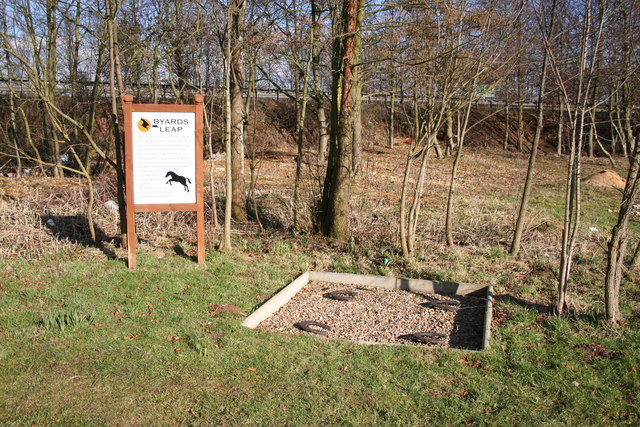Byard's Leap

Byard's Leap is a small hamlet in the civil parish of Cranwell, Brauncewell, and Byard's Leap, located within the North Kesteven district of Lincolnshire, England. It lies about three miles west of Cranwell and is steeped in local legend.
The site has historical ties to the Knights Templar, who are thought to have held tournaments or jousting events there. Byard's Leap stood at the southern boundary of their military training grounds at Temple Bruer.
One enduring legend from the area was recorded by folklorist Ethel Rudkin. It tells of a witch named Old Meg, a malevolent crone who lived in a cave or hut near a wooded area by the turnoff to Sleaford on Ermine Street, known locally as High Dike. She was feared for blighting crops and terrorizing the countryside. In desperation, the villagers called upon a local champion, a retired soldier, who pledged to kill the witch by driving a sword through her heart.
To choose a steed fit for the task, the soldier dropped a stone into a pond frequented by horses and selected the one that reacted the fastest. This horse, known as Blind Byard, was said to be blind.
When the soldier arrived at Old Meg’s dwelling and challenged her, she refused to emerge, claiming she was eating and he would have to wait. Instead, she crept up behind him and clawed at the horse, prompting it to bolt. Blind Byard leapt an astonishing sixty feet in a single bound. The soldier regained control near the pond, turned, and stabbed the witch through the heart. She fell into the water and drowned.
The landing spot of Blind Byard is marked today by four posts with horseshoes and a commemorative stone. The small limestone valley, though now softened by ploughing, is considered a plausible setting for the tale. Aerial views reveal High Dike running north to south at the center of the landscape, with RAF Cranwell to the east and the valley between them. Byard’s Leap lies toward the south-central portion of this area.
The name “Byard” may also echo the magical horse Bayard, a figure from several medieval romances on the Continent. The connection is fitting, as the Knights Templar, who remained active in Lincolnshire until their dissolution in 1312, owned land throughout the region. Their estate at Temple Bruer, situated on Lincoln Heath, was likely used not only for income but also for military preparation.